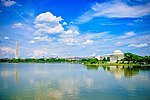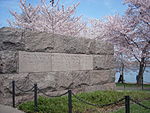Cuban Friendship Urn
1928 establishments in Washington, D.C.1928 sculpturesCuban-American historyMarble sculptures in Washington, D.C.Monuments and memorials in Washington, D.C. ... and 6 more
Monuments and memorials on the National Register of Historic Places in Washington, D.C.Neoclassical sculpturesOutdoor sculptures in Washington, D.C.Sculptures of birds in the United StatesSouthwest (Washington, D.C.)Spanish–American War memorials in the United States

The Cuban Friendship Urn, also known as the Cuban–American Friendship Urn or USS Maine Memorial, is a marble statue in Washington, D.C., listed on the National Register of Historic Places. The monument originally stood in Cuba to honor the American deaths aboard the USS Maine preceding the Spanish–American War in 1898.
Excerpt from the Wikipedia article Cuban Friendship Urn (License: CC BY-SA 3.0, Authors, Images).Cuban Friendship Urn
Ohio Drive Southwest, Washington
Geographical coordinates (GPS) Address External links Nearby Places Show on map
Geographical coordinates (GPS)
| Latitude | Longitude |
|---|---|
| N 38.878555555556 ° | E -77.03825 ° |
Address
Cuban American Friendship Urn
Ohio Drive Southwest
20227 Washington
District of Columbia, United States
Open on Google Maps











